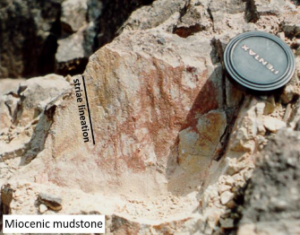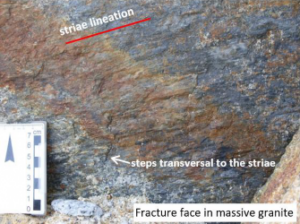Exercise 8
Photographs of three rock exposures are presented below. In each of them, the fracture face displays striae lineation that is assumed to be formed at the same time as the fracture, i.e., the striae lineation was not formed by reactivation.
a) In the following photograph, the fracture orientation is N40E/60SE and striae lineation on the surface is parallel to the dip of the fracture. What type of fracture is this? In which tectonic regime was it generated? What was the orientation of the principal stresses?

Photograph from Campinas, São Paulo, Brazil, by Amélia Fernandes
b) In the following photograph, the fracture orientation is N80E/88NW and striae lineation is subhorizontal. What fracture type is this? In which tectonic regime was it generated? What was the orientation of the principal stresses?

Photograph from Campinas, São Paulo, Brazil, by Amélia Fernandes
c) In the following photograph, the fracture orientation is EW/30S and striae lineation is parallel to the dip of the fracture. What fracture type is this? In which tectonic regime was it generated? What was the orientation of the principal stresses?

Photograph from Abitibi-Québec, Canada, by Alain Rouleau
